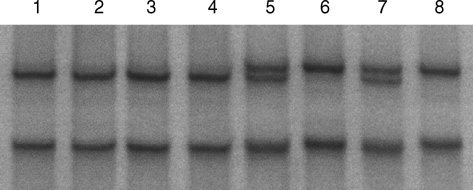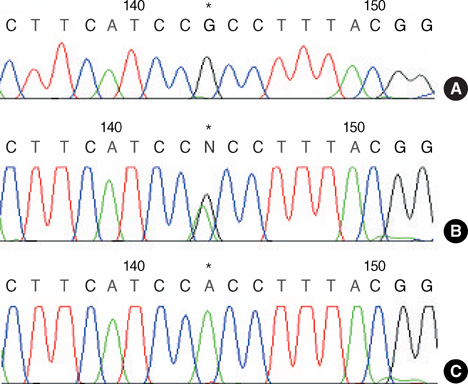J Korean Med Sci.
2007 Dec;22(6):998-1001. 10.3346/jkms.2007.22.6.998.
A Familial Case of Wiskott-Aldrich Syndrome with a Hotspot Mutation in Exon 2 of the WAS Gene
- Affiliations
-
- 1Department of Anatomy, School of Medicine, Keimyung University, Daegu, Korea. dkkim@dsmc.or.kr
- 2Department of Pediatrics, School of Medicine, Keimyung University, Daegu, Korea.
- 3Department of Physiology, School of Medicine, Keimyung University, Daegu, Korea.
- 4Institute for Medical Genetics, School of Medicine, Keimyung University, Daegu, Korea.
- 5Department of Anatomy, Yeungnam University College of Medicine, Daegu, Korea.
- 6Hanvit Institute for Medical Genetics, Daegu, Korea.
- KMID: 1785760
- DOI: http://doi.org/10.3346/jkms.2007.22.6.998
Abstract
- The Wiskott-Aldrich syndrome (WAS) is a severe X-linked disorder characterized classically by thrombocytopenia, immunodeficiency, and eczema. The phenotype observed in this syndrome is caused by mutation in the WAS gene. Peripheral blood DNAs were isolated from an 18-month-old boy with WAS and his mother, maternal uncle, and maternal grandmother. Genetic analysis for the detection of a mutation of WAS gene was performed by polymerase chain reaction-single strand conformational polymorphism analysis (PCR-SSCP) and direct sequencing of the PCR product. In PCR-SSCP, the patient and his maternal uncle had an abnormal shift band, which was not found in normal controls, and his mother and maternal grandmother showed heterozygous bands. In direct sequencing analysis, the patient with WAS had CGC-->CAC point mutation in exon 2 that resulted in an amino acid change in codon 86 (Arg86His). The present study identified a gene mutation responsible for WAS at a mutation hotspot of the WAS gene in a Korean family.
MeSH Terms
Figure
Reference
-
1. Sullivan KE, Mullen CA, Blaese RM, Winkelstein JA. A multiinstitutional survey of the Wiskott-Aldrich syndrome. J Pediat. 1994. 125:876–885.
Article2. Filipovich AH, Mathur A, Kamat D, Kersey JH, Shapiro RS. Lymphoproliferative disorders and other tumors complicating immunodeficiencies. Immunodeficiency. 1994. 5:91–112.3. Mullen CA, Anderson KD, Blaese RM. Splenectomy and/or bone marrow transplantation in the management of the Wiskott-Aldrich syndrome: long-term follow-up of 62 cases. Blood. 1993. 82:2961–2966.
Article4. Litzman J, Jones A, Hann I, Chapel H, Strobel S, Morgan G. Intravenous immunoglobulin, splenectomy, and antibiotic prophylaxis in Wiskott-Aldrich syndrome. Arch Dis Child. 1996. 75:436–439.
Article5. Filipovich AH, Stone JV, Tomany SC, Ireland M, Kollman C, Pelz CJ, Casper JT, Cowan MJ, Edwards JR, Fasth A, Gale RP, Junker A, Kamani NR, Loechelt BJ, Pietryga DW, Ringden O, Vowels M, Hegland J, Williams AV, Klein JP, Sobocinski KA, Rowlings PA, Horowitz MM. Impact of donor type on outcome of bone marrow transplantation for Wiskott-Aldrich syndrome: collaborative study of the International Bone Marrow Transplant Registry and the National Marrow Donor Program. Blood. 2001. 97:1598–1603.
Article6. Derry JM, Ochs HD, Francke U. Isolation of a novel gene mutated in Wiskott-Aldrich syndrome. Cell. 1994. 78:635–644.
Article7. Stewart DM, Treiber-Held S, Kurman CC, Facchetti F, Notarangelo LD, Nelson DL. Studies of the expression of the Wiskott-Aldrich syndrome protein. J Clin Invest. 1996. 97:2627–2634.
Article8. Villa A, Notarangelo L, Macchi P, Mantuano E, Cavagni G, Brugnoni D, Strina D, Patrosso MC, Ramenghi U, Sacco MG, Ugazio A, Vezzoni P. X-linked thrombocytopenia and Wiskott-Aldrich syndrome are allelic diseases with mutations in the WASP gene. Nat Genet. 1995. 9:414–417.
Article9. Schwarz K. WASPbase: a database of WAS- and XLT-causing mutations. Immunol Today. 1996. 17:496–502.
Article10. Imai K, Nonoyama S, Ochs HD. WASP (Wiskott-Aldrich syndrome protein) gene mutations and phenotype. Curr Opin Allergy Clin Immunol. 2003. 3:427–436.
Article11. Devriendt K, Kim AS, Mathijs G, Frints SG, Schwartz M, Van Den Oord JJ, Verhoef GE, Boogaerts MA, Fryns JP, You D, Rosen MK, Vandenberghe P. Constitutively activating mutation in WASP causes X-linked severe congenital neutropenia. Nat Genet. 2001. 27:313–317.
Article12. Ha TW, Han KH, Son DG, Kim SP, Kim DK. Analysis of loss of heterozygosity in Korean patients with keratoacanthoma. J Korean Med Sci. 2005. 20:340–343.
Article13. Imai K. WASPbase. Available from: http://homepage.mac.com/kohsukeimai/wasp/WASPbase.html.14. Jo EK, Futatani T, Kanegane H, Kubota T, Lee YH, Jung JA, Song CH, Park JK, Nonoyama S, Miyawaki T. Mutational analysis of the WASP gene in 2 Korean families with Wiskott-Aldrich syndrome. Int J Hematol. 2003. 78:40–44.15. Kim MK, Kim ES, Kim DS, Choi IH, Moon T, Yoon CN, Shin JS. Two novel mutations of Wiskott-Aldrich syndrome: the molecular prediction of interaction between the mutated WASP L101P with WASP-interacting protein by molecular modeling. Biochim Biophys Acta. 2004. 1690:134–140.
Article16. Hwang DJ, Yang JW, Kim SY, Yi HK, Lee DY, Hwang PH. Diagnostic Approach of Wiskott-Aldrich Syndrome. Korean J Pediatr. 2004. 47:726–734.17. Baek HJ, Choi SH, Sohn KR, Kook H, Kim SJ, Song ES, Han DK, Hwang TJ. Mutation Analysis in X-linked Recessive Congenital Immunodeficiency Syndromes. Chonnam Med J. 2005. 41:48–61.18. Kim HJ, Yoo EH, Ki CS, Yoo GH, Koo HH, Kim JW, Kim SH. A novel mutation W252X in the WAS gene in a Korean patient with Wiskott-Aldrich syndrome. Int J Hematol. 2006. 83:426–428.
Article19. Wengler GS, Notarangelo LD, Berardelli S, Pollonni G, Mella P, Fasth A, Ugazio AG, Parolini O. High prevalence of nonsense, frame shift, and splice-site mutations in 16 patients with full-blown Wiskott-Aldrich syndrome. Blood. 1995. 86:3648–3654.
Article20. Zhu Q, Watanabe C, Liu T, Hollenbaugh D, Blaese RM, Kanner SB, Aruffo A, Ochs HD. Wiskott-Aldrich syndrome/X-linked thrombocytopenia: WASP gene mutations, protein expression, and phenotype. Blood. 1997. 90:2680–2689.
Article21. Lemahieu V, Gastier JM, Francke U. Novel mutations in the Wiskott-Aldrich syndrome protein gene and their effects on transcriptional, translational, and clinical phenotypes. Hum Mutat. 1999. 14:54–66.
Article22. Greer WL, Shehabeldin A, Schulman J, Junker A, Siminovitch KA. Identification of WASP mutations, mutation hotspots and genotype-phenotype disparities in 24 patients with the Wiskott-Aldrich syndrome. Hum Genet. 1996. 98:685–690.
Article23. Schindelhauer D, Weiss M, Hellebrand H, Golla A, Hergersberg M, Seger R, Belohradsky BH, Meindl A. Wiskott-Aldrich syndrome: no strict genotype-phenotype correlations but clustering of missense mutations in the amino-terminal part of the WASP gene product. Hum Genet. 1996. 98:68–76.
Article24. Imai K, Morio T, Zhu Y, Jin Y, Itoh S, Kajiwara M, Yata J, Mizutani S, Ochs HD, Nonoyama S. Clinical course of patients with WASP gene mutations. Blood. 2004. 103:456–464.
Article25. Jin Y, Mazza C, Christie JR, Giliani S, Fiorini M, Mella P, Gandellini F, Stewart DM, Zhu Q, Nelson DL, Notarangelo LD, Ochs HD. Mutations of the Wiskott-Aldrich Syndrome Protein (WASP): hotspots, effect on transcription, and translation and phenotype/genotype correlation. Blood. 2004. 104:4010–4019.
Article
- Full Text Links
- Actions
-
Cited
- CITED
-
- Close
- Share
- Similar articles
-
- A Case of Wiskott-Aldrich Syndrome with 1316 G Deletion in Exon 10 on X-chromosome Treated with Allogeneic Cord Blood Transplantation
- A Case of Wiskott-Aldrich Syndrome with Novel Mutation in Exon 2 of the WASP Gene
- A case of familial X-linked thrombocytopenia with a novel WAS gene mutation
- A Case of Septic Arthritis in Patient with Wiskott-Aldrich Syndrome
- A Case of Wiskott-Aldrich Syndrome



